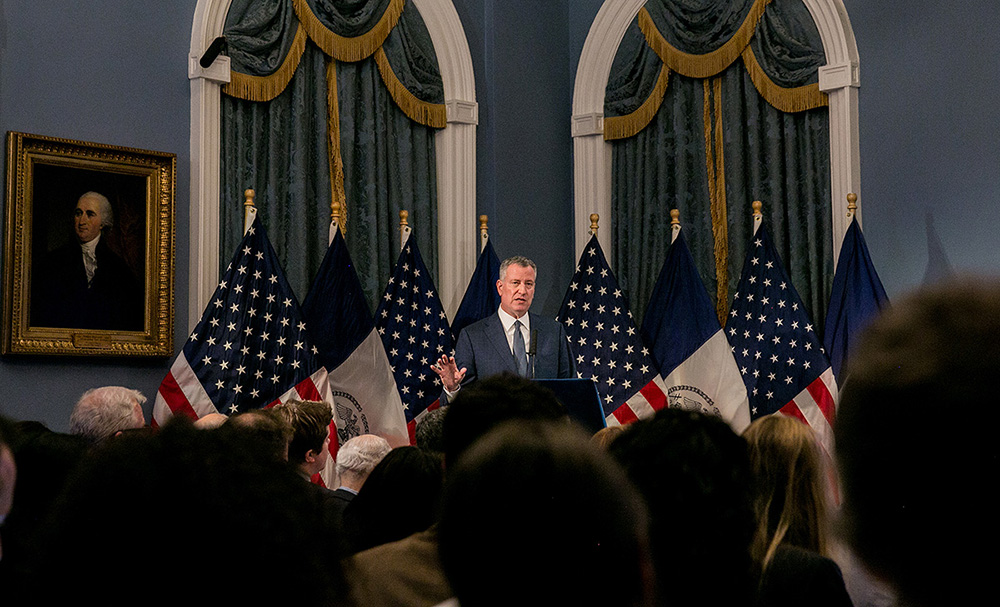Hard truths behind de Blasio's well-staged State of the City
Monday night, New York’s mayor was a halting afterthought at his own annual State of the City Address — the final such speech before Bill de Blasio’s re-election race. De Blasio still has no real vision for the city, nor any command of the street-level issues that New Yorkers face. But as New York continues to thrive, with its wealth putting it beyond day-to-day politics, the mayor’s no-there-there approach may be enough.
At the Apollo Theater, the mayor was the compliant, affable creation of the donors and consultants who made him (affable, at least, when not answering tough press questions). His speech was less interesting — and shorter — than the pre-show and after-show that cushioned it.
“As New York continues to thrive, with its wealth putting it beyond day-to-day politics, the mayor’s no-there-there approach may be enough.”
Before the speech, the mayor’s handlers had put together a parade of videos — carefully curated for their ethnic and gender content. The videos featured people who have done well — or, at least, OK — in de Blasio’s New York.
There were, of course, adorable preschool children. (Who can argue with that?) There was the younger woman who had helped New York’s public-housing residents get Wi-Fi. There was the elderly woman who was able to plan her retirement, thanks to the mayor’s two-year rent freeze.
And, most movingly, there was Conor McDonald, the 29-year-old NYPD sergeant whose father, Steven, died earlier this year, 30 years after being shot by a teenager in Central Park. After the speech, the mayor invited more heroic — albeit on a smaller scale — employees to the stage to celebrate their accomplishments.
But de Blasio is the beneficiary of how well our city works, not its creator. The mayor could afford to extend pre-K (the city had already started it under previous years) without raising taxes or cutting other services because, thanks in large part to Wall Street’s resurgence after 2008, it has more money than it knows what to do with.
Same with the city’s investments in public housing: The mayor is being generous in giving out other people’s ample money. A rent freeze? New York can only do that for longtime tenants because it has an infusion of younger people willing to pay much higher rents in the same older buildings, subsidizing longtime residents.
The mayor could leave crime as an afterthought — trumpeting record-low crime rates after 17 minutes of speech-making — because after nearly three decades of crime declines, many voters barely think about it.
Yes, the mayor deserves credit for keeping crime down even as the city has drastically reduced its street stops. But this works because New Yorkers were already feeling relaxed — it’s easier to experiment after your predecessors have succeeded wildly.
What were the mayor’s policy proposals? Well, not that much; he was just there to look the part. De Blasio took some credit for City Councilman Mark Levine’s bill to give New Yorkers at risk of eviction free legal counsel. Again, New York can afford this $93 million annual cost only because wealthier taxpayers are pouring in the funds.
The mayor pledged to levy a new “mansion tax” on people selling homes over $2 million, raising $336 million annually for senior housing.
But New York already has a mansion tax for people buying homes above $1 million. The mayor, with Albany’s (unlikely) permission, would thus be doubling an existing tax. This might make sense if de Blasio were to use the money to cut the sales tax or income taxes for middle-class residents. But de Blasio doesn’t want to reform taxes, only raise them.
And the mayor pledged 100,000 new high-paying jobs over a decade, more than $50,000 apiece. How to do that? Well, one clue is in the fact that between 2006 and 2016, New York created nearly 600,000 new jobs, including 120,000 jobs in the higher-paying business-services sector. This goal — absent plans to increase subway capacity or do much else to support growth — involves sitting back and hoping we continue to be lucky.
On harder issues — what to do about traffic, pedestrian deaths, homelessness, heroin addiction, a possibly slowing economy — the mayor was openly oblivious. “I am not going to go through topic after topic,” he said.
Nope — because de Blasio’s consultants know that most New Yorkers aren’t that desperate for answers, or for change. As it is, the mayor’s opponents are Preet Bharara and Cyrus Vance Jr. — who may indict him for doing too well the bidding of the people who made him the star of this expensive, well-choreographed show.
This piece originally appeared in the New York Post
______________________
Nicole Gelinas is a senior fellow at the Manhattan Institute and contributing editor at City Journal. Follow her on Twitter here.
This piece originally appeared in New York Post
